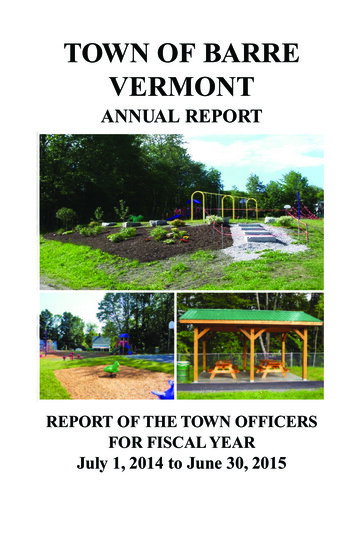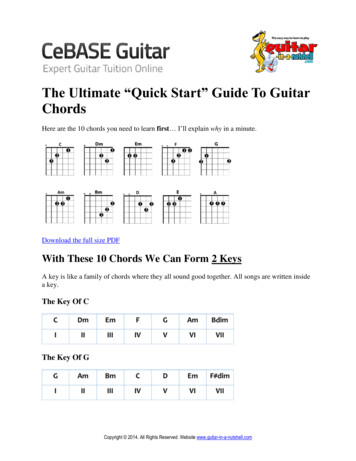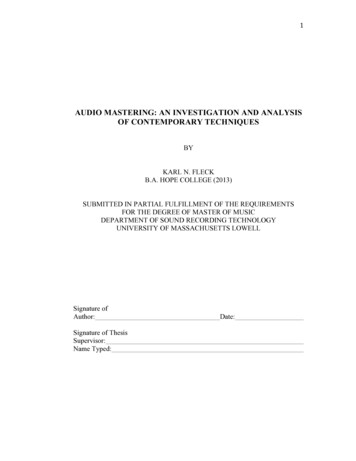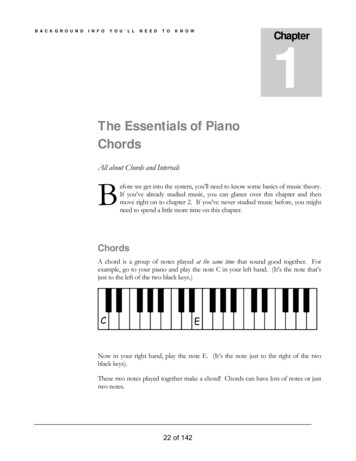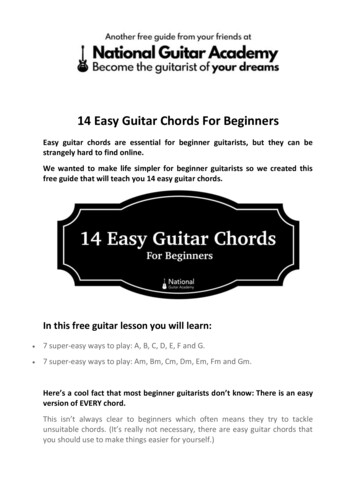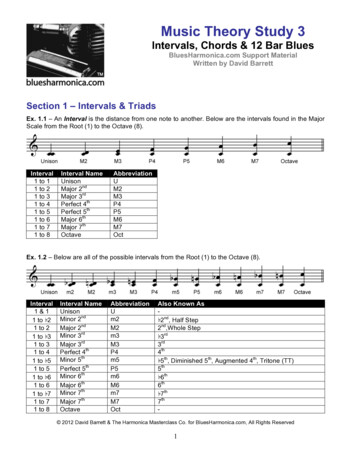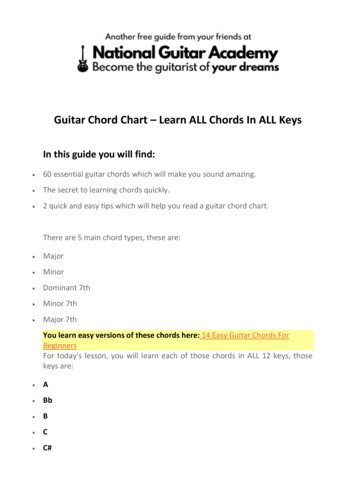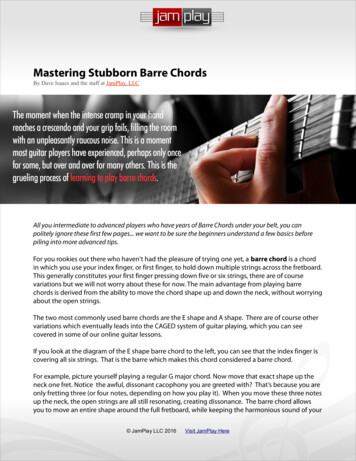
Transcription
Mastering Stubborn Barre ChordsBy Dave Isaacs and the staff at JamPlay, LLCAll you intermediate to advanced players who have years of Barre Chords under your belt, you canpolitely ignore these first few pages. we want to be sure the beginners understand a few basics beforepiling into more advanced tips.For you rookies out there who haven't had the pleasure of trying one yet, a barre chord is a chordin which you use your index finger, or first finger, to hold down multiple strings across the fretboard.This generally constitutes your first finger pressing down five or six strings, there are of coursevariations but we will not worry about these for now. The main advantage from playing barrechords is derived from the ability to move the chord shape up and down the neck, without worryingabout the open strings.The two most commonly used barre chords are the E shape and A shape. There are of course othervariations which eventually leads into the CAGED system of guitar playing, which you can seecovered in some of our online guitar lessons.If you look at the diagram of the E shape barre chord to the left, you can see that the index finger iscovering all six strings. That is the barre which makes this chord considered a barre chord.For example, picture yourself playing a regular G major chord. Now move that exact shape up theneck one fret. Notice the awful, dissonant cacophony you are greeted with? That’s because you areonly fretting three (or four notes, depending on how you play it). When you move these three notesup the neck, the open strings are all still resonating, creating dissonance. The barre chord allowsyou to move an entire shape around the full fretboard, while keeping the harmonious sound of your JamPlay LLC 2016Visit JamPlay Here
instrument intact. The name of the chord will change as you move it around, but if you are playing amajor chord shape, it will still be a major chord. Don’t worry if this doesn’t make sense at first, it cantake some time to understand barre chords and movable chord shapes!The E Shaped Barre ChordThis is one of the most commonly used barre chords, itis fairly easy to understand and not that difficult to play.The E Shape Barre chord gets it’s name from the E majoropen chord shape. If you glance to the right, you cansee a chord chart demonstrating the shape of the openchord. Normally, many individuals finger this different,using the first, second and third fingers, however thisfingering is necessary when the index finger is requiredfor the barre.Finger and play this shape on your guitar, and getcomfortable with it. Make sure all six strings are ringingout without any excessive buzzing or alternativelymuting. Once that is mastered, move this entire shapeup one fret. This would put your second finger on thesecond fret of the G string (3rd string), and your third and fourth fingers on the third fret of the Astring (5th) and D string (4th). Now play the chord. Can you hear how much different it sounds?It’s not exactly an ugly sound this time, but it certainly is no longer a major chord.Now, to make this chord complete, we will add the barre.If you look at the image to the right, you will see that allof the fingers stay in the same position, aside from thefirst finger, which is now covering all six strings on thefirst fret. Now strum all six strings. Don’t worry if at firstsome of the strings don’t ring out, or if your hand tiresquickly. We will talk a bit about properly playing thischord and exercises that can be done to improve playinglater.For now get used to the shape, and the idea in your headof using one finger to play six strings. Notice how thechord sounds right when strummed compared to notusing the first finger to create a barre. It is now a majorchord, which is what we were intending to play in thefirst place. JamPlay LLC 2016Visit JamPlay Here
Naming Barre ChordsThis a point of confusion for nearly everyone at first. If it is called an E shape barre chord, why does itbecome an F when moved one fret up the neck? That makes no sense! Don’t worry, it’s not nearly asdifficult as it sounds. When you refer to the E shape barre chord, you are only referring to the shapeyour second, third and fourth fingers make when playing an E major open chord. When the chord ismoved one fret up the neck, those three fingers are still in that shape, meaning for brevity’s sake itcan still be called an E shape barre chord. That is only the name of the shape though, not the chorditself.The name of the chord itself, in this case F major, comes from the root of the chord. The root note inthis chord is on the sixth string or E string. When the E major chord is played in the open position,you strum all six strings, making the open E string the root note. This of course makes it obviousthat the note played is an E, giving the chord the name E major. When you move up the fretboard,the first fret is an F making the chord an F major open chord. The second fret would be F# major,third fret G major, fourth fret G# major, fifth fret A Major and so one. Once you are able todifferentiate between the name of the shape and the name of the chord barre chords becomemuch less confusing.That's Great. I Can't Freaking Play It Cleanly.Before proceeding with the instruction on playing barre chords, it is prudent to mention a quicknote regarding guitar setup. Barre chords are hard for any new player, there is no denying that. Itrequires a level of strength and dexterity in the hand, wrist and forearm that very few possesswithout practice and dedication. It hurts, is uncomfortable and takes a lot of practice. But it is notimpossible.However, for some people, playing a clear sounding barre chord seems perpetually out of reach. Thereason for that is likely not their playing technique or strength, but rather an issue with the guitaritself. If the action of the guitar, the distance between the strings and fretboard, is too high it canmake playing barre chords nearly impossible. The same can be said for guitars of a pathetically lowquality. If barre chords are proving impossible for you, there are a few things you should try toremedy the situation before throwing the guitar down in a furious rage.1.) Check Your String GaugeOften, especially on acoustics, the guitars can come from the factory with a set of strings thatare fairly thick and difficult to play. This is done because it creates a richer tone, however theycan make it highly difficult for new players, or seasoned players with weaker hands, to play.Try going one set of strings lighter, and see if that helps. You may even try two, butdepending on your guitar, that may require a setup as the tension of the strings on your JamPlay LLC 2016Visit JamPlay Here
guitar will change. The lighter strings will make everything easier to play, from bends tobarre chords, which can be a real boon to a new player. The sound quality may suffer tosome small degree, but after a few hours you won’t even notice the difference.2.) Be Sure Your Guitar Setup is Accommodating.A proper setup will make any guitar easier to play, improve intonation and give an all aroundpremium experience. If you follow the advice above and switch to a set of strings that issignificantly lighter, a setup may be necessary to keep proper tune. It is highlyrecommended that you visit a guitar shop, tell their technician what kind of music you areplaying and give him information on any problems you are having, and get the proper stringgauge for you and a proper setup.3.) Consider a Different GuitarSuggesting a new guitar to remedy playing problems is generally the worst advice one cangive, however in this situation it may be prudent. If you have a really cheap guitar, somethingthat was under 100 new, and new strings and a good setup have not fixed things, a newguitar may be in your future. It is still recommended that you visit someone who knows theguitar well, and show them how you are attempting to play barre chords, and have themadvise you on whether the problem is with your technique or your instrument. If theproblem does turn out to be your instrument, and a setup and new strings have failed, it maybe time to buy a new guitar and this time spend a little bit more.(JUICY TIPS COMING) JamPlay LLC 2016Visit JamPlay Here
Ok My Guitar is Fine, Give me Advice Chris!It is highly likely that if this is your first time playing barre chords your first finger will either behurting, not properly holding down all of the strings or causing an awful lot of either unwantedbuzzing or unwanted muting. Don’t worry, these things are normal! Here are a few tips and ideaswhich can help make this process easier.Build The ChordForm non-barre notes of the chord first and add the index last instead of first. This helps withstretching and muscle memory. It also makes chord transitions easier when you are playing songs.Tilt the Index Finger!Many players have a tendency to keep the index finger (the barring finger) completely flat. It’smuch better if you tilt your index finger slightly the direction of the nut and the lower frets. Thisallows better contact of the index finger to the strings and fretboard and uses the muscle in yourarm more efficiently. JamPlay LLC 2016Visit JamPlay Here
Keep Your Thumb in a Power Position.When playing barre chords on the guitar you really must keep your thumb in the proper spot soyour hand can act as a clamp, which will make it easier to get the desired grip. Try to keep yourthumb towards the middle of the neck, roughly where the second finger is on the fretboard. Alsodon’t forget to have your wrist arched so your second, third and fourth fingers aren’t laying flat onthe fretboard. It will take some experimentation to find exactly what works for you, but theseguidelines should help.Check Your Posture.Use proper posture that allows more ofthe side of your finger to make the barre.Using the side of your finger avoids thefinger joints which are built in buzzmakers. Be sure to bring your thumbbehind your index finger on the back ofthe neck.Mind Your Strings.Remember you don’t actually need to playall six strings with the index finger. Whenit was said to play all six strings with theindex finger, that advice was mostly tohelp illustrate what a barre chord is. In theexample of the E shape, your finger really only needs to be playing the low E string (6th), G string(2nd) and high e string (3rd). This means you only need to focus the pressure from the finger onthose particular notes. There will be other barre chords covered in the future where the index fingerrealistically only needs to keep two notes compressed. JamPlay LLC 2016Visit JamPlay Here
Be Patient. Be Accurate.For some people that might mean a week or two, and for others it can be months. Don’t getdiscouraged and think that you won’t be able to play them because of the size or shape of thehands, or how weak you feel at any given time. Anyone can play barre chords, it just takes practice.perseverance and that “can do” attitude. These will take time to master.Build Strength.This exercise may not be for everyone, but it helped me build the strength to play barre chordsbetter and hold them longer quite rapidly. Place your index finger (and only your index finger, nochords here!) across the 9th fret on the fretboard, covering all six strings. Press down, and play eachstring individually until you manage to get all of the strings ringing out. Hold this position for aslong as you can. This will build up strength in your hand and cement the proper positioning intoyour muscle memory. Once you are able to do this on the 9th fret quite easily, move on to the 7thfret, then the 5th fret, on and on until you are able to master this exercise upon the first fret. Thisability to do this well and hold the position for a long period of time will certainly not comeovernight, but it will help build up the strength required playing barre chords.Mind the Pressure.Don't psych yourself out. You probably think barre chords are hard and and that can have a majoreffect on tension. Too much tension when playing barre chords will reduce your stamina and yourhand will cramp up much quicker. It is better to do it right 3 times, than wrong 30. Play themaccurately as best as you can today. and repeat that tomorrow. After a few weeks, your hands willnaturally start to adapt to the chord, the strength required, and the stamina needed to performthem reliably. JamPlay LLC 2016Visit JamPlay Here
Have Limited Time To Practice?Want a Step-by-Step Plan For Practicing Barre Chords?Dave Isaacs put together an easy to follow 28 day barre chord practice plan for you.This is a proven system that will have you playing barre chords like a pro in just 28 days!Click here to learn more about this practice plan JamPlay LLC 2016Visit JamPlay Here
variations which eventually leads into the CAGED system of guitar playing, which you can see covered in some of our online guitar lessons. If you look at the diagram of the E shape barre chord to the left, you can see that the index finger is covering all six strings. That is the barre which makes this chord considered a barre chord.
